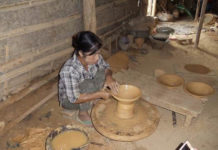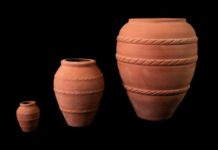Jordan has good clay deposits and a continuous history of pottery since the Neolithic period. Traditionally, pottery is practiced across Jordan using wood kilns and local clays to produce water ewers and planting pots.
Contemporary Jordan ceramics take on different forms. Some artists produce original works of ceramic art, such as Hazem Al Zoubi, Mahmoud Taha and Raed Dahleh. Others make functional products out of clay, such as tableware and ornaments for decoration. The handicraft pottery and ceramics in Jordan is sustained by a range of agencies, including NGOs, community organizations, and small enterprises. Ceramic businesses include Arabesque for mosaic ceramic, Beit al Bawadi Showroom, Mosaic and Ceramic Art, Petra pottery, Saltos-Ceramic-Art, and The Vocational Training center at Salt traditional crafts.
In prehistory, Jordan’s Nabataean pottery was distinguished by the fine thin-ware or eggshell ware (pinkish/red color) demonstrating the skill of the craftspersons. It was often decorated with brown flower and leaf designs in primitive style on red clay. These decorations are still in use in Petra Pottery Association designs.
One distinguishing form of Jordanian pottery is “ceramic mosaics”, which is inspired by stone mosaic. It is made by incising patterns shaped and colored like mosaics on the surface of the pot. This particular technique had been recognized after Mr. Raed Al Badri won the Award of Excellence for Handicrafts in 2014 from World Crafts Council in Indonesia.

Ceramic mosaics, photo: Adeeb Atwan
Ceramic mosaics are widely used as gifts for social and cultural celebrations. Sometimes they convey religious meaning when decorated with Quranic inscriptions.
There are some variations in the use of ceramics in Jordan. Petra pottery in the south, for instance, often takes the Nabataean primitive style, while the workshops in the middle and north parts of the country produce ceramic with Arabic calligraphy and Islamic designs.
References
Bala’awi, F., & Alawneh, F. Physical and Chemical Investigations of Ancient Ceramic, Jordan.
Jordan, E. o. t. H. K. o. (2008). HISTORY, From Antiquity to Modernity. Retrieved 2/16, 2016, from http://www.jordanembassyus.org/page/history






Further contemporary ceramic manufacturers have emerged the last decade, introducing complicated technologies in ceramics involving crystalline glazes.
From those are Aymen Azzam
I agree with you Aymen. You are one of the new generation artists in Jordan.